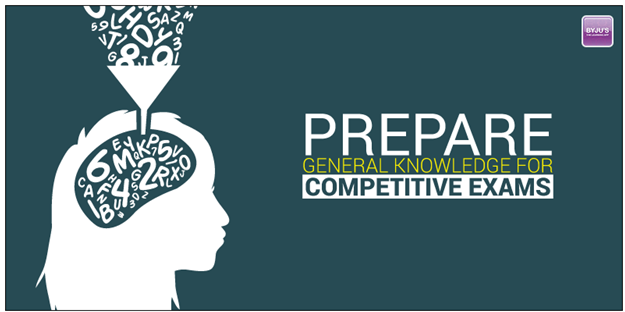-
 Rukmini Devi (1904 -1986) was an Indian dancer and choreographer of the Indian classical dance form of Bharatnatyam.
Rukmini Devi (1904 -1986) was an Indian dancer and choreographer of the Indian classical dance form of Bharatnatyam. - She was born in an upper class Brahmin family in Madurai.
- In 1920 she married Dr.George Arundale, a prominent British Theosophist who was closely associated with Annie Besant.
- During the 1930s Rukmini met Bharatnatyam by E. Krishna Iyer, founder-secretary of the Madras Music Academy.They fought a successful battle to save Bharatnatyam which seemed likely to be buried along with the disfavoured devadasi system as it was considered a low and vulgar art in the early 1920s and known as sadhir.
Famous Indian Women : Rukmini Devi Arundale
15 Apr 2017
By
Admin
Related Posts with thumbnails for bloggerblogger widgets
Continue reading..
How to Prepare General Knowledge (GK) for Competitive Exams
By
Admin
General Knowledge. As the term says, the subject entails knowledge about the general stuff around us (Wow, thanks for the brand new info bro). Talking seriously, General Knowledge is a section that most of the students stress about when sitting for a government exam such as IAS, UPSC or other competitive exams such as CAT, IIT-JEE, NEET etc.
An exceptional command over general knowledge will not only yield good results in the examination hall but also in Interviews and group discussions. General awareness, like common sense is not that common in students as they are much more engrossed in the curriculum served to them on a platter. We in this article try to provide you with some tips on how to prepare General Knowledge for examinations.
Related Posts with thumbnails for bloggerblogger widgets
Continue reading..
NCERT Standard 8 : Materials Metals and Nonmetals Class 8 Notes
18 Apr 2015
By
Admin
The property of metals by which they can be beaten into thin sheets is called malleability.
The property of metal by which it can be drawn into wires is called ductility.
Since metals produce ringing sounds, they are said to be sonorous. The materials other than metals are not sonorous.
Related Posts with thumbnails for bloggerblogger widgets
Continue reading..
NCERT Standard 8 : Microorganisms Friend and Foe Class 8 Notes
By
Admin
Microorganisms are classified into four major groups. These groups are bacteria, fungi, protozoa and some algae. Virus reproduce only inside the cells of the host organism, which may be a bacterium, plant or animal. Common ailments like cold, influenza (flu) and most coughs are caused by viruses. Serious diseases like polio and chicken pox are also caused by viruses. Diseases like dysentery and malaria are caused by protozoans whereas typhoid and tuberculosis (TB) are bacterial diseases.
Related Posts with thumbnails for bloggerblogger widgets
Continue reading..
What is Net Neutrality
14 Apr 2015
By
Admin
Net neutrality is the principle that Internet service providers and governments should treat all data on the Internet equally, not discriminating or charging differentially by user, content, site, platform, application, type of attached equipment, or mode of communication.
The case for net neutrality has slowly but firmly attained critical mass and entered the mainstream consciousness supported by politicians and celebrities like Digvijay Singh, Shahrukh Khan and Farhan Akhtar tweeting their support for a free internet. The debate caught public imagination especially after an AIB video explaining net neutrality went viral on the web to the extent that Facebook had to take it off after it’s algos decided the video was spam. But the video was restored shortly, say reports.
Related Posts with thumbnails for bloggerblogger widgets
Continue reading..
NCERT Standard 8 - Crop Production and Management Class 8
11 Apr 2015
By
Admin
1. Which among the following is a Kharif Crop?
(a) Wheat
(b) Gram
(c) Mustard
(d) Rice
Rice is the right answer.
The crops which are sown in the rainy season are called kharif crops. The rainy season in India is generally from June to September. Paddy, maize, soyabean, groundnut, cotton, etc., are kharif crops.
The crops grown in the winter season are called rabi crops. Their time period is generally from October to March. Examples of rabi crops are wheat, gram (parippu), pea, mustard and linseed.
The crops which are sown in the rainy season are called kharif crops. The rainy season in India is generally from June to September. Paddy, maize, soyabean, groundnut, cotton, etc., are kharif crops.
The crops grown in the winter season are called rabi crops. Their time period is generally from October to March. Examples of rabi crops are wheat, gram (parippu), pea, mustard and linseed.
Related Posts with thumbnails for bloggerblogger widgets
Continue reading..
Kerala PSC - Kerala Renaissance Questions And Answers
By
Admin
1. Who gave the revolutionary message - No Caste, No Religion, No God for Man?
(a) Swadeshabhimani Ramakrishna Pillai
(b) Ayya Vaikundar
(c) Sahodaran Ayyapan
(d) Mannathu Padmanabhan
Sahodaran Ayyapan is the right answer.
He founded the Vidhya Poshini Sabha. In 1917 he started the a movement for interdining and founded the ‘‘Sahodara sangham’’. "Sahodaran" was a paper started by Sahodaran Ayyappan.
He founded the Vidhya Poshini Sabha. In 1917 he started the a movement for interdining and founded the ‘‘Sahodara sangham’’. "Sahodaran" was a paper started by Sahodaran Ayyappan.
Related Posts with thumbnails for bloggerblogger widgets
Continue reading..




